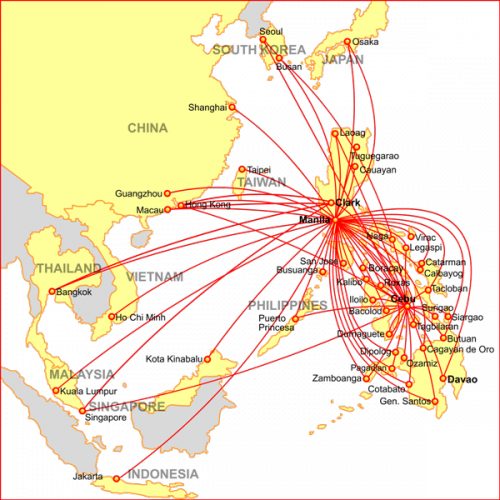Cebu Pacific is now the Philippines' largest carrier of domestic and international flown passengers and has plans to serve Brunei from August and Beijing from September. The carrier has been able to wrestle market share away from national carrier, Philippine Airlines - Routes News examines the market.
Last year low-fare carrier Cebu Pacific handled 8.8 million domestic and international passengers - a 31% year-on-year rise.
This year, it expects to handle 10 million passengers and by 2013, a further five million. This will exceed the current capacity at Manila Ninoy Aquino's Terminal 3, which is Cebu Pacific's main hub and also the home airport for national carrier, Philippine Airlines.
Manila Airport faces severe capacity constraints and the problem is so severe that it is set to be downgraded from its current status as the country's major gateway. The Department of Transportation and Communications (DOTC) has designated Diosdado Macapagal International Airport (DMIA), a former air base, as the country's premier international airport for the longer term and a major phased redevelopment is underway there.
Cebu Pacific's current route network:

From Diosdado Macapagal International Airport (DMIA), the carrier flies to just four international destinations: Bangkok, Macau, Hong Kong and Singapore. Plus, Cebu Pacific currently remains committed to expansion from Manila but is also focused on neighbouring Clark Airport.
"We see Clark Airport as a developing hub that can cater to our North Luzon passengers, as well as to those who are looking for an alternative entry point to the Philippines," says Cebu's Pacific's vice-president for marketing and distribution, Candice Iyog.
Cebu Pacific's biggest presence is at Manila, where it flies to 15 international destinations, which includes its upcoming services to Brunei on August 21 and Beijing on September 5.
Iyog spoke to Routes News about the new services: "We decided to fly to Brunei to serve overseas Filipino workers there. Beijing is our third destination in China, after Guangzhou and Shanghai, and we can stimulate the market with our low-fares."
She added: "We would also like to grow our network to Japan, China and Australia."
Within its international network, Cebu Pacific also flies from Cebu to Hong Kong, Singapore, Incheon and Pusan.
Competition in the Philippines
A comparison of Cebu Pacific and Philippine Airlines' top 10 markets in 2005 and 2010 shows where the low-fares carrier has successfully gained market share.
|
Destination |
Cebu Pacific weekly Frequency |
Philippine Airlines Weekly Frequency |
Total Weekly Frequency |
|
Cebu (CEB) |
53 |
53 |
106 |
|
(DVO) |
28 |
21 |
49 |
|
Bacolod (BCD) |
21 |
21 |
42 |
|
(ILO) |
21 |
21 |
42 |
|
(CGY) |
14 |
21 |
35 |
|
Hong Kong (HKG) |
14 |
21 |
35 |
|
(TAC) |
14 |
14 |
28 |
|
(ZAM) |
7 |
14 |
21 |
|
(KLO) |
7 |
11 |
18 |
|
(TAG) |
7 |
9 |
16 |
|
Total |
373 |
||
2010
|
Destination |
Cebu Pacific weekly Frequency |
Philippine Airlines Weekly Frequency |
Total Weekly Frequency |
|
Cebu (CEB) |
72 |
57 |
129 |
|
(MPH) |
80 |
80 |
|
|
(DVO) |
43 |
35 |
78 |
|
(ILO) |
42 |
35 |
77 |
|
Bacolod (BCD) |
35 |
35 |
70 |
|
(CGY) |
35 |
34 |
69 |
|
Hong Kong (HKG) |
28 |
35 |
63 |
|
Singapore (SIN) |
25 |
28 |
53 |
|
(TAC) |
28 |
21 |
49 |
|
(KLO) |
21 |
22 |
43 |
|
Total Weekly Flights |
711 |
||
Source: FlightBase, 14-20 September 2010
Cebu Pacific currently competes on nine of Philippine Airlines' top 10 markets and serves more than half of the national carrier's combined weekly frequencies - 409 flights a week out of 711.
Cebu Pacific operates only narrow-bodies and regional aircraft and its new order for 22 additional A320s, to be delivered between 2010 until 2014 will make the airline's Airbus fleet the largest in the country, consisting of 33 A320s, 10 A319s and eight ATR 72-500s.





